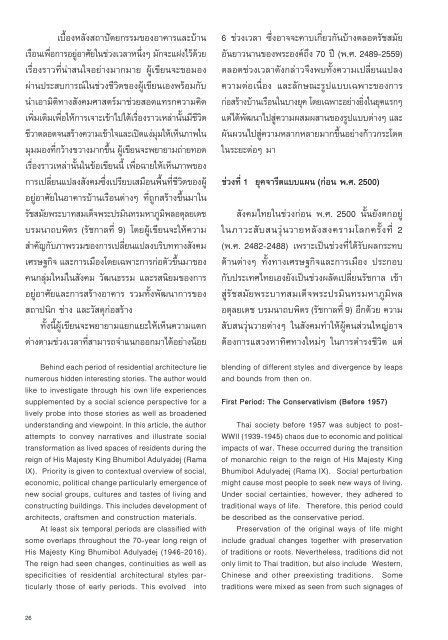บ้านเรือนถิ่นไทยในช่วงเจ็ดทศวรรษ 2489-2559
Create successful ePaper yourself
Turn your PDF publications into a flip-book with our unique Google optimized e-Paper software.
เบื้องหลังสถาปัตยกรรมของอาคารและบ้าน<br />
เรือนเพื่อการอยู่อาศัยในช่วงเวลาหนึ่งๆ มักจะแฝงไว้ด้วย<br />
เรื่องราวที่น่าสนใจอย่างมากมาย ผู้เขียนจะขอมอง<br />
ผ่านประสบการณ์ในช่วงชีวิตของผู้เขียนเองพร้อมกับ<br />
นาเอามิติทางสังคมศาสตร์มาช่วยสอดแทรกความคิด<br />
เพิ่มเติมเพื่อให้การเจาะเข้าไปใต้เรื่องราวเหล่านั้นมีชีวิต<br />
ชีวาตลอดจนสร้างความเข้าใจและเปิดแง่มุมให้เห็นภาพใน<br />
มุมมองที่กว้างขวางมากขึ้น ผู้เขียนจะพยายามถ่ายทอด<br />
เรื่องราวเหล่านั้นในข้อเขียนนี้ เพื่อฉายให้เห็นภาพของ<br />
การเปลี่ยนแปลงสังคมซึ่งเปรียบเสมือนพื้นที่ชีวิตของผู้<br />
อยู่อาศัยในอาคารบ้านเรือนต่างๆ ที ่ถูกสร้างขึ้นมาใน<br />
รัชสมัยพระบาทสมเด็จพระปรมินทรมหาภูมิพลอดุลยเดช<br />
บรมนาถบพิตร (รัชกาลที่ 9) โดยผู้เขียนจะให้ความ<br />
สาคัญกับภาพรวมของการเปลี่ยนแปลงบริบททางสังคม<br />
เศรษฐกิจ และการเมืองโดยเฉพาะการก่อตัวขึ้นมาของ<br />
คนกลุ่มใหม่ในสังคม วัฒนธรรม และรสนิยมของการ<br />
อยู่อาศัยและการสร้างอาคาร รวมทั้งพัฒนาการของ<br />
สถาปนิก ช่าง และวัสดุก่อสร้าง<br />
ทั้งนี้ผู้เขียนจะพยายามแยกแยะให้เห็นความแตก<br />
ต่างตามช่วงเวลาที่สามารถจาแนกออกมาได้อย่างน้อย<br />
Behind each period of residential architecture lie<br />
numerous hidden interesting stories. The author would<br />
like to investigate through his own life experiences<br />
supplemented by a social science perspective for a<br />
lively probe into those stories as well as broadened<br />
understanding and viewpoint. In this article, the author<br />
attempts to convey narratives and illustrate social<br />
transformation as lived spaces of residents during the<br />
reign of His Majesty King Bhumibol Adulyadej (Rama<br />
IX). Priority is given to contextual overview of social,<br />
economic, political change particularly emergence of<br />
new social groups, cultures and tastes of living and<br />
constructing buildings. This includes development of<br />
architects, craftsmen and construction materials.<br />
At least six temporal periods are classified with<br />
some overlaps throughout the 70-year long reign of<br />
His Majesty King Bhumibol Adulyadej (1946-2016).<br />
The reign had seen changes, continuities as well as<br />
specificities of residential architectural styles particularly<br />
those of early periods. This evolved into<br />
6 ช่วงเวลา ซึ่งอาจจะคาบเกี่ยวกันบ้างตลอดรัชสมัย<br />
อันยาวนานของพระองค์ถึง 70 ปี (พ.ศ. <strong>2489</strong>-<strong>2559</strong>)<br />
ตลอดช่วงเวลาดังกล่าวจึงพบทั้งความเปลี่ยนแปลง<br />
ความต่อเนื่อง และลักษณะรูปแบบเฉพาะของการ<br />
ก่อสร้างบ้านเรือนในบางยุค โดยเฉพาะอย่างยิ่งในยุคแรกๆ<br />
แต่ได้พัฒนาไปสู่ความผสมผสานของรูปแบบต่างๆ และ<br />
ผันผวนไปสู่ความหลากหลายมากขึ้นอย่างก้าวกระโดด<br />
ในระยะต่อๆ มา<br />
ช่วงที่ 1 ยุคจารีตแบบแผน (ก่อน พ.ศ. 2500)<br />
สังคมไทยในช่วงก่อน พ.ศ. 2500 นั้นยังตกอยู่<br />
ในภาวะสับสนวุ่นวายหลังสงครามโลกครั้งที่ 2<br />
(พ.ศ. 2482-2488) เพราะเป็นช่วงที่ได้รับผลกระทบ<br />
ด้านต่างๆ ทั้งทางเศรษฐกิจและการเมือง ประกอบ<br />
กับประเทศไทยเองยังเป็นช่วงผลัดเปลี่ยนรัชกาล เข้า<br />
สู่รัชสมัยพระบาทสมเด็จพระปรมินทรมหาภูมิพล<br />
อดุลยเดช บรมนาถบพิตร (รัชกาลที่ 9) อีกด้วย ความ<br />
สับสนวุ่นวายต่างๆ ในสังคมทาให้ผู้คนส่วนใหญ่อาจ<br />
ต้องการแสวงหาทิศทางใหม่ๆ ในการดารงชีวิต แต่<br />
blending of different styles and divergence by leaps<br />
and bounds from then on.<br />
First Period: The Conservativism (Before 1957)<br />
Thai society before 1957 was subject to post-<br />
WWII (1939-1945) chaos due to economic and political<br />
impacts of war. These occurred during the transition<br />
of monarchic reign to the reign of His Majesty King<br />
Bhumibol Adulyadej (Rama IX). Social perturbation<br />
might cause most people to seek new ways of living.<br />
Under social certainties, however, they adhered to<br />
traditional ways of life. Therefore, this period could<br />
be described as the conservative period.<br />
Preservation of the original ways of life might<br />
include gradual changes together with preservation<br />
of traditions or roots. Nevertheless, traditions did not<br />
only limit to Thai tradition, but also include Western,<br />
Chinese and other preexisting traditions. Some<br />
traditions were mixed as seen from such signages of<br />
26


















